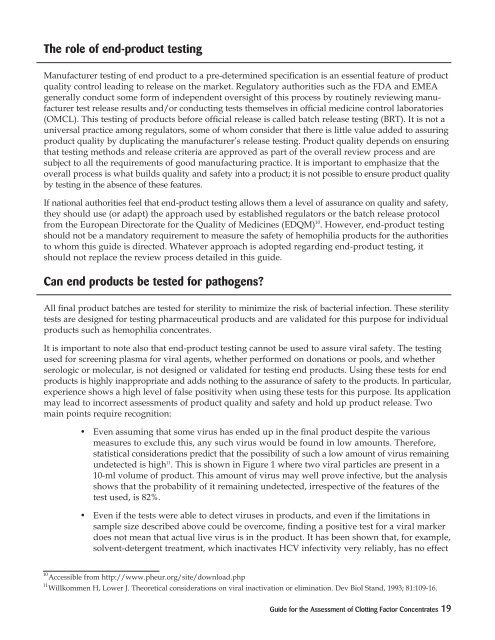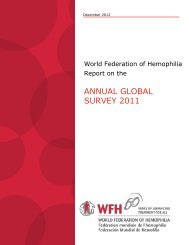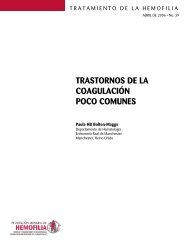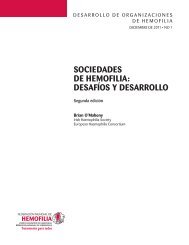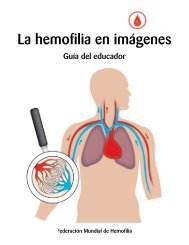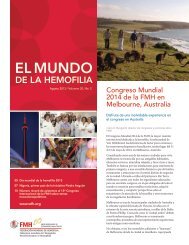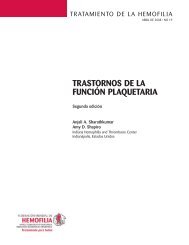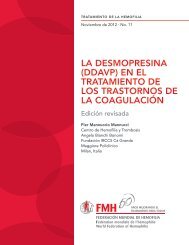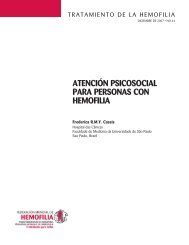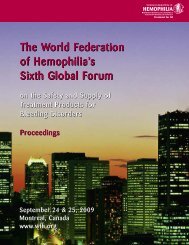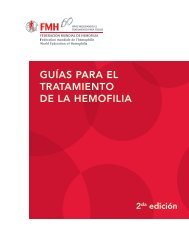Guide for the Assessment of Clotting Factor Concentrates
Guide for the Assessment of Clotting Factor Concentrates
Guide for the Assessment of Clotting Factor Concentrates
Create successful ePaper yourself
Turn your PDF publications into a flip-book with our unique Google optimized e-Paper software.
The role <strong>of</strong> end-product testingManufacturer testing <strong>of</strong> end product to a pre-determined specification is an essential feature <strong>of</strong> productquality control leading to release on <strong>the</strong> market. Regulatory authorities such as <strong>the</strong> FDA and EMEAgenerally conduct some <strong>for</strong>m <strong>of</strong> independent oversight <strong>of</strong> this process by routinely reviewing manufacturertest release results and/or conducting tests <strong>the</strong>mselves in <strong>of</strong>ficial medicine control laboratories(OMCL). This testing <strong>of</strong> products be<strong>for</strong>e <strong>of</strong>ficial release is called batch release testing (BRT). It is not auniversal practice among regulators, some <strong>of</strong> whom consider that <strong>the</strong>re is little value added to assuringproduct quality by duplicating <strong>the</strong> manufacturer’s release testing. Product quality depends on ensuringthat testing methods and release criteria are approved as part <strong>of</strong> <strong>the</strong> overall review process and aresubject to all <strong>the</strong> requirements <strong>of</strong> good manufacturing practice. It is important to emphasize that <strong>the</strong>overall process is what builds quality and safety into a product; it is not possible to ensure product qualityby testing in <strong>the</strong> absence <strong>of</strong> <strong>the</strong>se features.If national authorities feel that end-product testing allows <strong>the</strong>m a level <strong>of</strong> assurance on quality and safety,<strong>the</strong>y should use (or adapt) <strong>the</strong> approach used by established regulators or <strong>the</strong> batch release protocolfrom <strong>the</strong> European Directorate <strong>for</strong> <strong>the</strong> Quality <strong>of</strong> Medicines (EDQM) 10 . However, end-product testingshould not be a mandatory requirement to measure <strong>the</strong> safety <strong>of</strong> hemophilia products <strong>for</strong> <strong>the</strong> authoritiesto whom this guide is directed. Whatever approach is adopted regarding end-product testing, itshould not replace <strong>the</strong> review process detailed in this guide.Can end products be tested <strong>for</strong> pathogens?All final product batches are tested <strong>for</strong> sterility to minimize <strong>the</strong> risk <strong>of</strong> bacterial infection. These sterilitytests are designed <strong>for</strong> testing pharmaceutical products and are validated <strong>for</strong> this purpose <strong>for</strong> individualproducts such as hemophilia concentrates.It is important to note also that end-product testing cannot be used to assure viral safety. The testingused <strong>for</strong> screening plasma <strong>for</strong> viral agents, whe<strong>the</strong>r per<strong>for</strong>med on donations or pools, and whe<strong>the</strong>rserologic or molecular, is not designed or validated <strong>for</strong> testing end products. Using <strong>the</strong>se tests <strong>for</strong> endproducts is highly inappropriate and adds nothing to <strong>the</strong> assurance <strong>of</strong> safety to <strong>the</strong> products. In particular,experience shows a high level <strong>of</strong> false positivity when using <strong>the</strong>se tests <strong>for</strong> this purpose. Its applicationmay lead to incorrect assessments <strong>of</strong> product quality and safety and hold up product release. Twomain points require recognition:• Even assuming that some virus has ended up in <strong>the</strong> final product despite <strong>the</strong> variousmeasures to exclude this, any such virus would be found in low amounts. There<strong>for</strong>e,statistical considerations predict that <strong>the</strong> possibility <strong>of</strong> such a low amount <strong>of</strong> virus remainingundetected is high 11 . This is shown in Figure 1 where two viral particles are present in a10-ml volume <strong>of</strong> product. This amount <strong>of</strong> virus may well prove infective, but <strong>the</strong> analysisshows that <strong>the</strong> probability <strong>of</strong> it remaining undetected, irrespective <strong>of</strong> <strong>the</strong> features <strong>of</strong> <strong>the</strong>test used, is 82%.• Even if <strong>the</strong> tests were able to detect viruses in products, and even if <strong>the</strong> limitations insample size described above could be overcome, finding a positive test <strong>for</strong> a viral markerdoes not mean that actual live virus is in <strong>the</strong> product. It has been shown that, <strong>for</strong> example,solvent-detergent treatment, which inactivates HCV infectivity very reliably, has no effect10 Accessible from http://www.pheur.org/site/download.php11 Willkommen H, Lower J. Theoretical considerations on viral inactivation or elimination. Dev Biol Stand, 1993; 81:109-16.<strong>Guide</strong> <strong>for</strong> <strong>the</strong> <strong>Assessment</strong> <strong>of</strong> <strong>Clotting</strong> <strong>Factor</strong> <strong>Concentrates</strong> 19


